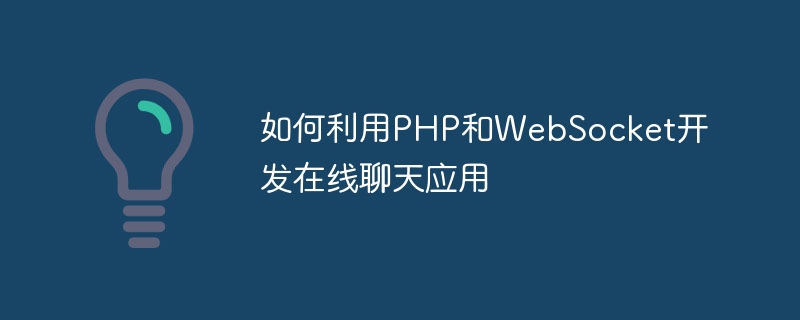Home >Backend Development >PHP Tutorial >How to develop online chat applications using PHP and WebSocket
How to develop online chat applications using PHP and WebSocket
- PHPzOriginal
- 2023-12-18 10:33:521438browse

How to use PHP and WebSocket to develop online chat applications
Introduction:
With the development of the Internet, online chat applications are becoming more and more popular. An important technology for developing real-time chat applications is WebSocket. WebSocket is a protocol that implements full-duplex communication. It can establish a long connection between the browser and the server, allowing the server to actively push data to the browser, thereby achieving real-time communication. In this article, we'll show you how to develop a simple online chat application using PHP and WebSocket, along with concrete code examples.
-
Environment preparation:
Before developing the WebSocket real-time chat application, we need to ensure that the server-side and client-side environments meet the requirements. The specific preparations are as follows:- Server environment: Make sure the server has PHP installed and supports WebSocket.
- Client environment: The browser supports WebSocket, and most modern browsers already support WebSocket.
-
Create a WebSocket server:
First, we need to create a WebSocket server to receive and process client connections and messages. In PHP, you can use the Ratchet library to create a WebSocket server. The following is a code example for creating a WebSocket server:<?php require 'vendor/autoload.php'; use RatchetMessageComponentInterface; use RatchetConnectionInterface; use RatchetServerIoServer; use RatchetHttpHttpServer; use RatchetWebSocketWsServer; class ChatApplication implements MessageComponentInterface { protected $clients; public function __construct() { $this->clients = new SplObjectStorage; } public function onOpen(ConnectionInterface $conn) { $this->clients->attach($conn); echo "New connection! ({$conn->resourceId}) "; } public function onMessage(ConnectionInterface $from, $msg) { echo $msg . " "; foreach ($this->clients as $client) { $client->send($msg); } } public function onClose(ConnectionInterface $conn) { $this->clients->detach($conn); echo "Connection {$conn->resourceId} has disconnected "; } public function onError(ConnectionInterface $conn, Exception $e) { echo "An error has occurred: {$e->getMessage()} "; $conn->close(); } } $server = IoServer::factory( new HttpServer( new WsServer( new ChatApplication() ) ), 8080 ); $server->run();The above code creates a WebSocket server through several classes provided by the Ratchet library. The ChatApplication class implements the MessageComponentInterface interface, which is used to handle client connections, messages, and disconnections. and error handling. We can customize relevant logic according to business needs.
-
Create client page:
Next, we need to create a client page to establish a WebSocket connection with the server and realize the interactive effect of the chat page. The following is a basic client page code example:<!DOCTYPE html> <html> <head> <title>WebSocket Chat</title> <script> var socket = new WebSocket("ws://localhost:8080"); socket.onopen = function() { console.log("WebSocket connection established."); }; socket.onmessage = function(event) { console.log("Received message: " + event.data); var message = JSON.parse(event.data); var li = document.createElement("li"); li.textContent = message.content; document.getElementById("messages").appendChild(li); }; socket.onclose = function() { console.log("WebSocket connection closed."); }; function sendMessage() { var messageText = document.getElementById("message").value; var message = { content: messageText }; socket.send(JSON.stringify(message)); document.getElementById("message").value = ""; } </script> </head> <body> <h1>WebSocket Chat</h1> <ul id="messages"></ul> <input type="text" id="message" placeholder="Type a message..."> <button onclick="sendMessage()">Send</button> </body> </html>The above code uses JavaScript to create a WebSocket object, and uses event callback functions to handle events such as receiving messages, establishing and closing connections. To send a message, use the send() method of the WebSocket object to send data in JSON format.
- Start the WebSocket server:
In the above code, we set the address of the WebSocket server to "ws://localhost:8080", so before running, please make sure that WebSocket has been started server. - Run the test:
When the server and client are ready, we can access the client page through the browser to test the real-time chat function. When you enter a message in the text box and click the send button, the message will be sent to the server through the WebSocket connection, and then the server will send the message to all connected clients, thereby achieving the effect of real-time chat.
Summary:
This article introduces the basic steps and code examples on how to develop an online chat application using PHP and WebSocket. By reusing existing libraries and frameworks, we can quickly build a simple real-time chat application. Of course, actual projects may require further optimization and expansion, such as message encryption, authentication, database storage, etc., which require corresponding development and adjustments based on specific needs. I hope this article can help you understand and apply WebSocket to develop online chat applications.
The above is the detailed content of How to develop online chat applications using PHP and WebSocket. For more information, please follow other related articles on the PHP Chinese website!

